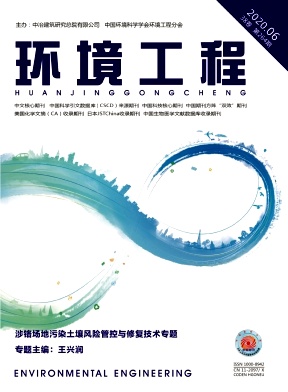|
IARC. IARC monographs on the evaluation of carcino-genic risks to humans volume 49 chrome, nickel and welding[R]. Geneva: World Health Organization, 1997: 17-33.
|
|
王兴润, 李丽, 刘雪,等. 铬渣治理技术的应用进展及特点分析[J]. 中国给水排水, 2009, 25(4): 10-14.
|
|
纪柱. 铬渣长期堆存后的组成变化及对治理的影响[J]. 无机盐工业, 2006,38(9): 8-12.
|
|
DERMATAS D, CHRYSOCHOOU M, MOON D H, et al. Ettringite induced heave in chromite ore processing residue (COPR) upon ferrous sulfate treatment[J]. Environmental Science & Technology, 2006, 40(18): 5786-5792.
|
|
MOON D H, WAZNE M, DERMATAS D, et al. Long-term treatment issues with chromite ore processing residue (COPR): Cr6+ reduction and heave[J].Journal of Hazardous Materials, 2007, 143(3): 629-635.
|
|
JAGUPILLA S C, MOON D H, WAZNE M, et al. Effects of particle size and acid addition on the remediation of chromite ore processing residue using ferrous sulfate [J]. Journal of Hazardous Materials, 2009, 168(1): 121-128.
|
|
WANG X, ZHANG J D, WANG L L, et al. Long-term stability of FeSO4·7H2O and H2SO4 treated chromite ore processing residue (COPR): importance of H+ and SO42- [J]. Journal of Hazardous Materials, 2017, 321(5): 720-727.
|
|
许友泽. 铬渣堆场污染土壤微生物修复工艺研究[D].长沙:中南大学,2009.
|
|
沈瑜潇. 有机酸协同黄铁矿对Cr(Ⅵ)的还原作用研究[D].南京:南京农业大学,2010.
|
|
崔晋艳, 钱天伟, 丁庆伟, 等. 纳米级天然黄铁矿去除水中Cr6+,Cd2+和Pb2+[J].环境工程学报,2016,10(12):7103-7108.
|
|
臧磊. 硫精矿处理电镀重金属废水的研究[D].西安:西安建筑科技大学,2008.
|
|
王倩. 铁矿石-微生物协同去除水中Cr(Ⅵ)的研究[D].杭州:浙江大学,2010.
|
|
傅贤书. 硫化铁处理含铬废水的进一步研究[J]. 西安冶金建筑学院学报, 1988, 20(1): 1-9.
|
|
陈永亨, 张平, 梁敏华,等. 黄铁矿对重金属的环境净化属性探讨[J]. 广州大学学报(自然科学版), 2007, 6(4): 23-25.
|
|
杨广平, 张胜林, 张林生,等. 含铬废水还原处理的条件及效果研究[J]. 电镀与环保, 2005, 25(2): 38-40.
|
|
李喜林, 王来贵, 赵奎,等. 铬渣浸溶Cr(Ⅵ)溶解释放规律研究:以锦州堆场铬渣为例[J]. 地球与环境, 2013, 41(5): 518-523.
|
|
鲁安怀. 天然铁的硫化物净化含铬污水的新方法[J]. 地学前缘, 1998, 5(2): 242.
|
|
鲁安怀. 矿物法—环境污染治理的第四类方法[J]. 地学前缘, 2005, 12(1): 196-205.
|
|
BOSTICK B C, FENDORF S. Arsenite sorption on troilite (FeS) and pyrite (FeS2)[J].Geochimica et Cosmochimica Acta, 2003, 67(5): 909-921.
|
|
LU P, CHEN T, LIU H, et al. Green preparation of nanoporous pyrrhotite by thermal treatment of pyrite as an effective Hg(Ⅱ) adsorbent: performance and mechanism[J]. Minerals, 2019, 9(2):74.
|
|
王延明. 铁的硫化矿物对砷的吸附机理研究[D].合肥:合肥工业大学,2012.
|
|
MACHIDA M, YAMAZAKI R. Role of minerals in carbonaceous adsorbents for removal of Pb(Ⅱ) ions from aqueous solutions [J]. Separation and Purifcation Technology, 2005, 46(1/2):88-94.
|
|
ERDEM M, OZVERDI A. Kinetics and thermodynamics of Cd(Ⅱ) adsorption onto pyrite and synthetic iron sulphide [J]. Separation and Purification Technology, 2006, 51(3): 240-246.
|
|
史亚丹. 煅烧黄铁矿结构演化及其净化水中砷的作用和机理[D].合肥:合肥工业大学,2015.
|
|
DUAN Y H, HAN D S, BATCHELOR B, et al. Synthesis, characterization, and application of pyrite for removal of mercury [J]. Colloids and Surfaces A: Physicochemical Engineering Aspects, 2016, 490: 326-335.
|
|
SPRYNSKYY M, BUSZEWSKI B, TERZYK A P, et al. Study of the selection mechanism of heavy metal (Pb2+, Cu2+, Ni2+, and Cd2+) adsorption on clinoptilolite [J]. Journal of Colloid and Interface Science, 2006, 304(1): 21-28.
|
|
CHANDRA A P, GERSON A R. The mechanisms of pyrite oxidation and leaching: a fundamental perspective[J]. Surface Science Reports, 2010, 65(9): 293-315.
|


 Login
Login Register
Register E-alert
E-alert






 DownLoad:
DownLoad: